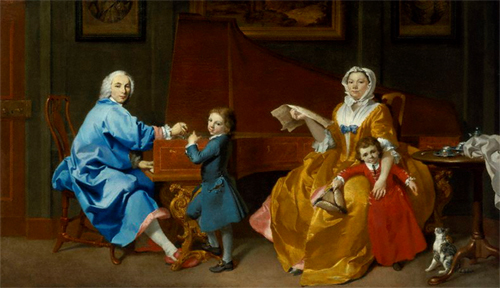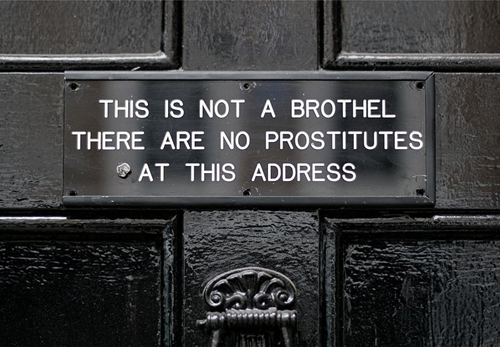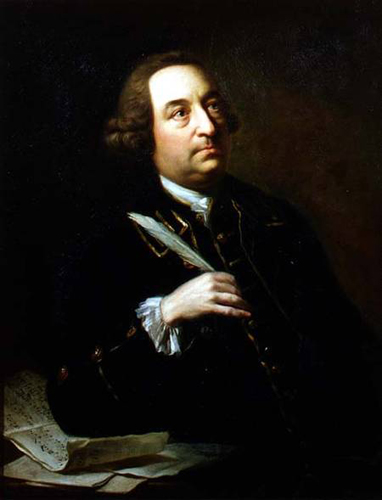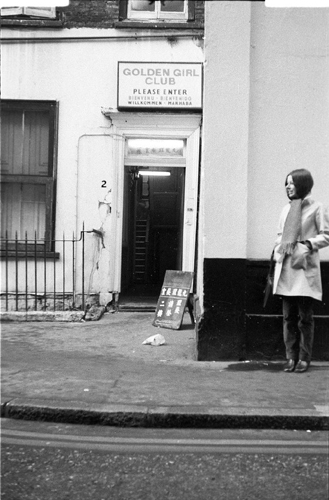
Meard Street, in Soho, London, was designed and built as a speculative development by John Meard a local builder and businessman. The eastern, wider part of Meard Street, containing Nos. 1–7 (odd) and Nos. 2–6 (even), was built on the Pitt estate, that to the west being built on the Pulteney estate. In both parts, however, the building leases were made to the same lessee, John Meard.1
Nos. 1, 3, 5 and 7 form a terrace of four single-fronted houses of 1732, planned in pairs with mirrored arrangements so that the doorways of Nos. 3 and 5 are conjoined. Each house contains a basement and four storeys. The plan is that of the conventional terrace house, with a passage-hall and a dog-legged staircase at the side of a large front and a smaller back room with a closet opening off the latter, the closet-wing being only three storeys high.
The four-storeyed fronts are quite uniform, all the houses having, in their upper storeys, three evenly spaced windows. Wide piers occur between Nos. 1 and 3, and 5 and 7, where the chimney-stacks are paired in the party walls. The ground storey of each house was faced with stucco in the 19th century, jointed to resemble stone, and at first-floor sill level is a plain stucco bandcourse, perhaps covering one of red brick. The upper storeys are faced with brown stock bricks, red brick being used for the jambs and gauged flat arches of the window-openings, which have stone sills and contain moulded box-frames, slightly recessed. The double-hung sashes are evidently mid-Victorian, each being divided by a single vertical glazing-bar.

I carried out a full analysis of the paint in one of these houses.
Some Notable Residents
No. 1. Burkat Shudi (Burckhardt Tschudi), harpsichord-maker, 1738–42. From 1840-47 it was the Westminster Female Penitent Asylum.
No. 3. Rev. Richard Terrick, later Bishop of London, 1739–42.2

No. 7. Sebastian Horsley, artist and dandy.
No. 9. First occupant, Mrs. White, 1733–5. Batty Langley, the architectural writer, was assessed for rates at No. 9 in 1739–40 and 1742–5 (in succession to Elizabeth Langley in 1738). In 1741 his brother, Thomas, an engraver, was assessed. They were carrying on their business as surveyors and designers of buildings and gardens here in 1740 and 1742. (In the former year Thomas also advertised that he taught architecture and drawing to ‘young gentlemen’).
Elizabeth Flint, ‘generally slut and drunkard; occasionally whore and thief’ had a furnished room here at No. 9 Meard Street in 1758 at 5s. per week. It was probably in reference to this house that Samuel Johnson observed:
“Bet … had, however, genteel lodgings, a spinnet on which she played, and a boy that walked before her chair.”
No. 11. First occupant, Wyriott Ormond, 1733–4; Abraham Browne ‘one of his Majesty’s and of the Queen’s Band, and First Violin at Ranelagh‘, 1755–70; Francis, John, and John Nott Sartorius, painters, 1775–6.

No. 18. First occupant, Johann Christoph Schmidt, friend of George Frideric Handel and father of (John) Christopher Smith, musician (1712–95), 1723–47.
No. 20. First occupant, Mr. Barbo (? Barbault), 1722–4; Batty Langley, 1746?–1750 (see No. 9 above); François A. D. Philidor, chess-player and composer, in 1753.
The nature of Meard Street has changed considerably over the years. Between 1754-76 John Shebbeare, the political writer, lived at No. 2. In the 1960s it was the Golden Girl Club and it is now in residential use.

Notes
1 Most of this has been taken from ‘The Pitt Estate in Dean Street: Meard Street’, Survey of London: volumes 33 and 34: St Anne Soho (1966), pp. 238-246.
2 He later lived at Fulham Palace.











No comments yet. Be the first!